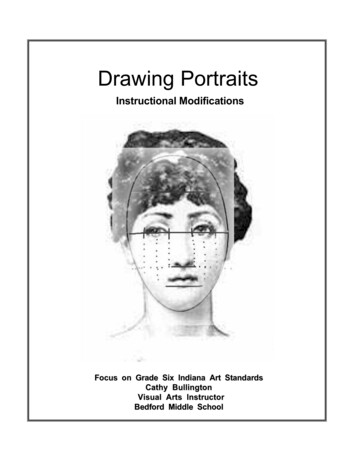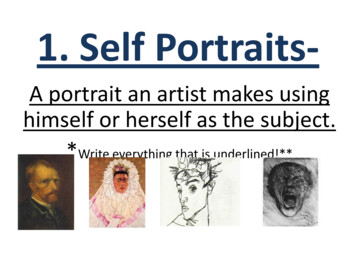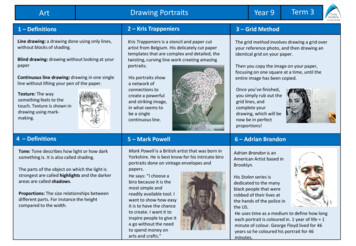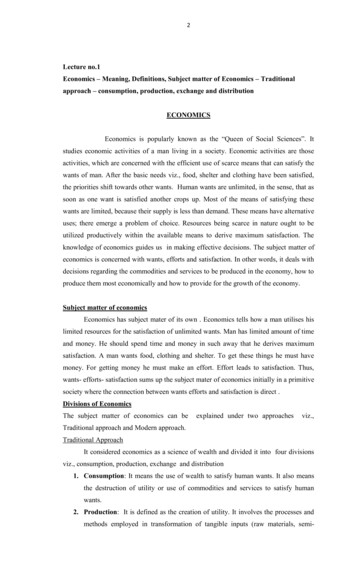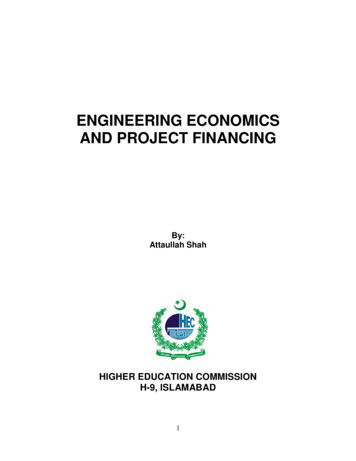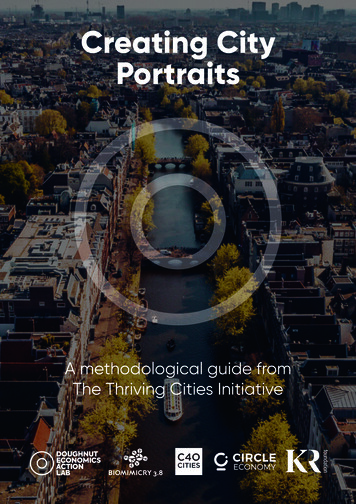
Transcription
Creating CityPortraitsA methodological guide fromThe Thriving Cities Initiative
ContentsTowards Thriving Cities3The Purpose of this Guide41. The Doughnut meets the City5Downscaling the Doughnut: From Global Compass to City Portrait9 ways to turn the City Portrait into transformative action792. What would it mean for the people of the city to thrive?10Local–Social Lens3. What would it mean for the city to thrive withinits natural habitat?16Local–Ecological Lens4. What would it mean for the city to respect the healthof the whole planet?22Global–Ecological Lens5. What would it mean for the city to respect the wellbeingof people worldwide?28Global–Social Lens6. The City Portrait as a Transformative Tool34Interconnections in the City PortraitFrom Public Portrait to City SelfieNew Perspectives for Policy Development and Analysis363839Principles for Putting Doughnut Economics into Practice40Further Development of the City Portrait x 1: Additional Details for Amsterdam’sGlobal–Ecological Lens44
A methodological guide from The Thriving Cities Initiative 3Towards Thriving CitiesCities have a unique role and opportunity to shape humanity’s chancesof thriving in balance with the rest of the living planet this century.As home to more than 4 billion people – over55% of the world’s population – cities accountfor over 60% of global energy use, and more than70% of global greenhouse gas emissions, due tothe global footprint of the products they importand consume1. At the same time, there are vastinequalities in city residents’ experience of urbanlife, ranging from health, housing, and politicalrepresentation to access to essential services,employment, and wider opportunities.The growing impact of 21st century crises – fromclimate breakdown, global health pandemicand economic crisis – is placing severe, recurringstress on many of the world’s cities. As theyseek to manage and emerge from theseinterconnected crises, cities have a criticalopportunity to lead in making the transformationsneeded to create societies and economies thatare far more socially just and ecologically safe.In other words, cities can aim to thrive by buildingwellbeing and resilience, not only in their owncity but in the wider world.The C402 works with over 90 of the world’s largestcities to drive meaningful and measurable actionon climate change, on the scale required to limitglobal heating to within 1.50 Celsius. C40 Citiesare taking an integrated and inclusive approachto reducing emissions and adapting to climaterisk, aiming to maximise and distribute social,environmental, and economic benefits equitably.The Thriving Cities Initiative (TCI) is a collaborationbetween the C40, Doughnut Economics ActionLab3, and Circle Economy 4, funded by the KRFoundation5. TCI aims to work with some of theC40’s most pioneering cities to explore andpursue ambitious actions to meet the goal ofliving well, within the means of the living planet,and in the process, to reduce their consumptionbased greenhouse gas (GHG) emissions.The TCI’s ‘City Portrait’ is a transformative toolfor cities to explore and embrace the vision ofa thriving city – a vision that recognises whatmakes a place unique, while also recognising70%Cities account formore than 70% ofglobal greenhousegas emissionsits global influence and responsibility. Themethodology for creating the City Portrait arisesout of a conceptual collaboration between KateRaworth of Doughnut Economics Action Lab andJanine Benyus of Biomimicry 3.8 6, and is describedin detail in this document.Through the TCI’s pilot programme, themethodology was developed and applied in thecities of Philadelphia, Portland, and Amsterdam in2019. This Guide presents the steps taken to applythis first version of the City Portrait methodologyin these three cities, and is illustrated withexamples from Amsterdam’s City Portrait 7, alongwith some ways in which the resulting portrait canbe turned into a transformative tool. By publishingthis guide, we are making the methodologyavailable to be applied and adapted in othercities and places.Together with diverse city representatives, wehave embarked upon a journey to understandhow to create cities that are home to thrivingpeople in a thriving place, while respecting thewellbeing of all people and the health of thewhole planet. We believe this place-basedmethodology has the potential to be adaptedbeyond its first application to global North cities,in order to make it relevant and useful for citiesin the global South, and also for neighbourhoods,towns, nations, and regions. We invite you to joinus as we co-create approaches to meet thisurgent 21st century challenge.
4 Creating City PortraitsThe Purpose ofthis GuideWe have created this guide because we are making the City Portraitmethodology freely available to all who are interested in downscalingthe Doughnut to their city or place, and we want to make it as simpleand straightforward as possible for others to do.For the most effective process and results,we recommend that the team creatingthe City Portrait works collaborativelyand involves: multidisciplinary researchers with a mixof qualitative and quantitative skills city staff representing a wide range ofcity departments city-based civic organisations andcommunity networks.Each of the four ‘lenses’ of themethodology can be investigated in manyways, depending on multiple factors suchas context, resources, time, and dataavailability. Throughout the Guide, wedescribe the methods that were chosento create the Thriving City Portraits inPortland, Philadelphia, and Amsterdam,and we also identify useful resources andalternative approaches that we cameacross in the process.This Guide represents the first version ofan evolving methodology – please sharethoughts, comments, and lessons learnedfrom applying it with the Thriving CitiesInitiative, through joining the growingcommunity of practitioners at DoughnutEconomics Action Lab3, and through theC40 Thriving Cities Discussion Forum8 sothat, together, we can keep making it morerelevant to more places, at many scales.The approach described in this Guidewas developed primarily with a focuson global North cities with high levelsof resource consumption and largeecological footprints. In future iterations,we will be adapting and extending thisapproach in order to: place greater focus on the role and impactof history, power relations, and legaciesof colonialism in global North cities develop an approach for global Southcities that better reflects their needs,interests, and perspectives adapt the approach for use at multiplescales, ranging from neighbourhoodsto nations or bioregions.We look forward to discussing, collaboratingwith, and learning from others throughthese co-creative processes.
A methodological guide from The Thriving Cities Initiative 5SECTION 1TheDoughnutmeets theCityIn this sectionDownscaling the Doughnut: FromGlobal Compass to City Portrait79 ways to turn the City Portraitinto transformative action9
6 Creating City PortraitsFigure 1 The Doughnut of socialand planetary boundariesclimatechangethefoodair pollutionicalchem ntiopolluLALTFOR educationSHincome& workgenderequalitypeace OVhealthhousingENac ocid eaifi ncattyniwaterGBetween the social foundation and the ecologicalceiling lies a doughnut-shaped space in which it ispossible to meet the needs of all people within themeans of the living planet – an ecologically safeand socially just space in which humanity can thrive.Gjust space forndhumeafL FOUNDATIaONsa SOCIAnetworksREThe Doughnut’s ecological ceiling comprisesnine planetary boundaries, drawn up by Earthsystem scientists in order to identify Earth’s criticallife-supporting systems and define the globallimits of pressure that these systems can safelyendure10. Humanity must live within these ecologicalboundaries if we are to preserve a stable climate,fertile soils, healthy oceans, a protective ozonelayer, ample freshwater, and abundantbiodiversity on Earth.G I CAL CEI LINenergyys iterdiv sbio losThe Doughnut’s social foundation, which is derivedfrom the social priorities in the UN SustainableDevelopment Goals 9, sets out the minimumstandard of living to which every human beinghas a claim. No one should be left in the hole inthe middle of the Doughnut, falling short on theessentials of life, ranging from food and water togender equality and having a political voice.OLOph nos itrph ogeor n &usloadingECnioryelae tionneo pleozdThe Doughnut of social and planetaryboundaries envisions a world in whichpeople and planet can thrive in balance– in other words, it offers a compass forguiding 21st century prosperity, as shownin Figure 1 11.IVEE AND DIS TRIB UTECONrate lshwfres rawadwithco landnversionFigure 2 Transgressing both sidesof the Doughnut’s boundariesBeyond the boundaryBoundary not quantifiedclimatechangeeneozde onetworksicalchem tionpollucationeduLALTFORSHtysoequci ialtyc o lan dnversioncap o l i t ic ev oilap e juterw a lsfreshdrawaw it hho ns p it r oho geru n &sloadin gnge ueqst c eic &engin c o& w meorkh o usial d e rit yTOOSHEROVlthair pollutionac ocLECILMIECNATLACNGEINLOid eaOOLIGNVCIRifi nGcaENEfooderwatL FOUNDATIheyONCIAargSOntioerlayonne letipsierdiv sbio lo sIf humanity’s goal is to get into the Doughnut, thechallenge is that we are currently far from doingso, as shown in Figure 2. Worldwide, billions ofpeople still cannot meet their most essential needs,yet humanity is collectively overshooting at leastfour planetary boundaries, and is driving towardsclimate breakdown and ecological collapse. Thered wedges below the social foundation in Figure 2show the proportion of people worldwide currentlyfalling short on life’s essentials12. The wedgesradiating beyond the ecological ceiling showthe current overshoot of planetary boundaries.The challenge of our times is that we must movewithin the Doughnut’s boundaries from both sidessimultaneously, in ways that promote the wellbeingof all people and the health of the whole planet.Achieving this globally calls for action on manylevels, including in cities, which are proving to beleaders of driving such change. The City Portraitaims to amplify that potential.p
A methodological guide from The Thriving Cities Initiative 7Downscaling the Doughnut: From GlobalCompass to City PortraitSince it was first published in 2012, the Doughnuthas gained considerable international attention– from cities and towns to the United Nations,and across many layers of society, suchas social enterprises, community activists,businesses, educators, and governments. TheDoughnut has been downscaled in many wayssince it was created, but we believe the CityPortrait methodology described in this Guiderepresents the most holistic approach so far,for two main reasons:Our motivation is to find the most effective ways totranslate the Doughnut into a tool for city-level holisticthinking and decision-making, while recognising cities’very diverse realities. The City Portrait methodology isthe best response that we have come up with so far,and it can be distilled down to a single core questionfor a city:1. Local aspirations, global responsibility:When a city asks itself this very 21st century question,the result is a holistic snapshot of city performanceacross four crucial ‘lenses’ that arise from combiningtwo domains (social and ecological) and two scales(local and global). Each of these interconnected lensesfocuses on a part of the overarching question at thecore of the City Portrait, as shown in Figure 3 below.The City Portrait methodology combines local aspirations– to be thriving people in a thriving place – with globalresponsibility – both social and ecological – that requiresevery place to consider its many complex interconnectionswith the world in which it is embedded.How can our city be a home tothriving people, in a thriving place,whilst respecting the wellbeing of all people,and the health of the whole planet?2. Scalable: Our focus here is on the city scale, but weare confident that the methodology can be adapted tobe applied across scales, from neighbourhood to nation(and beyond).SOCIALECOLOGICALLOCALWhat would itmean for thepeople of this cityto thrive?What would itmean for this cityto thrive withinits natural habitat?GLOBALFigure 3 The four lenses of the City PortraitWhat would itmean for thiscity to respect thewellbeing of peopleworldwide?What would itmean for this cityto respect thehealth of thewhole planet?
8 Creating City PortraitsTaken together, the four lenses of the City Portraitare intended to start and inform a public discussionabout what it would mean for your city to achievelocal aspirations, while respecting the rights andaspirations of others, and the living planet. Withthis overall purpose in mind, our design of theCity Portrait methodology has followed fivebroad criteria:Be locally relevant, rather than comparablebetween cities. The City Portrait does notseek to produce directly comparable portraitsbetween cities, either within the same nation orbeyond. There are already multiple initiativesthat aim to create such city-to-city comparisons,and these can be extremely valuable in situatinga given city’s performance in a wider context.What is lost in such comparisons, however, is thespecificity of place, the character of community,and the relevance of historical and culturalcontext – all of which can be crucial entry pointsfor civic reflection. The City Portrait forgoes strictcomparability in order to best reflect these traits,meaning that each city’s portrait and its relatedmetrics will look, feel, and turn out differently.Aim to compare desired outcomes versuscurrent performance. The ultimate aspirationfor each of the four lenses of the portrait is to beable to compare a city’s desired performance toits current performance. The targets and datarequired to make this kind of comparison are,however, currently lacking for many cities. But inthese relatively early days of devising metrics fitfor measuring thriving cities, such data gaps areto be expected, and one of the best ways to fillthem is to create demand for them.Create an opportunity for tracking progressand devising policy. The data and informationused to create the four lenses of the portrait canbe tracked and updated over time, creating thepossibility of tracking progress in each of thelenses. Some monitoring could be done by thecity’s residents themselves, so they get engagedand participate in the measuring process, andhelp to amplify – and celebrate – progress. Citiescan also use the portrait for reflecting on thepossible impacts and implications of initiativesand policies under consideration.Offer a holistic ‘snapshot’ for discussingcomplex issues. Each of the four lenses depictsjust a fraction of the possible city data that couldbe shown. Rather than overwhelm stakeholderswith detail, the City Portrait aims to engage themwith judiciously selected data and quotes that givea snapshot of the whole and provide an overviewperspective. As these four simple lenses of a city’scurrent reality are brought together, they inviteholistic reflection on the very complex dynamicsthat underpin their interconnections. In this way,the portrait aims to help open up discussionsabout possible transformative pathways.Take the long view. Humanity is in the very earlydays of creating metrics that are fit for 21st centuryrealities. Our current approach to quantifying theCity Portrait has many caveats (set out throughoutthis Guide). In a decade or so we will look back atthis first methodology and see it as very crude.Indeed it is, but we will only make progress inassessing what it means to thrive if we start wherewe are and keep pushing ourselves to improve.This is teamwork: we invite suggestions.The City Portrait has proved to be a challengingand thought-provoking starting point to explorethe socio-economic and ecological dynamicsthat are driving consumption-intensive behaviour,lifestyle patterns, and systemic inequalities. At thesame time, the City Portrait invites a city to createand pursue a more holistic vision of what it meansto thrive through an iterative process of change,as set out in the nine M’s on the following page.
A methodological guide from The Thriving Cities Initiative 99Nine Ways to Turnthe City Portrait intoTransformative 7Momentum8MonitorReflect on the current state ofthe city through the portrait’sholistic perspectiveBring together thecity changemakers andstakeholders neededto bring about changeEmbrace the values, ways ofworking, and new narrativesthat underpin the deepershifts requiredCreate an iterative process thatdrives cycles of transformativepolicy and action9Mmm!Create a compelling visionof what it means to becomea thriving cityIdentify existing initiatives,policies, and strategies thatare already taking the cityin this directionDraw on complementary toolsthat serve to expand the CityPortrait’s analysis and deepenits insightsAssess progress againstleading indicators thatenrich the City PortraitMake it irresistible: be creative, have fun, sharelearning and stories of success - and celebrate!
10 Creating City PortraitsSECTION 2Local–Social Lens:What would it meanfor the people of thecity to thrive?In this sectionSelect Local–Social Dimensions11Do official city targets exist, and arethey sufficient?12Select City Performance Indicators13Contextual sense-check13
A methodological guide from The Thriving Cities Initiative 11The Local–Social lens of the City Portraitasks what ‘thriving’ means to the peopleof your city, and compares that aspirationwith a snapshot of the city’s currentperformance. Although there are manyways to answer this question, the generaldecisions that need to be made are shownin Figure 4. In practice, making these decisionswill always be an iterative process – a kindof dance between the project team, theavailability of data and resources, andthe city-specific context.we selected a set of sixteen social dimensions, mostof which are derived from the Doughnut’s socialfoundation (which, in turn, is drawn from the UnitedNations Sustainable Development Goals (SDGs)13.Other dimensions – such as community, culture, andequality in diversity (adding racial equality to genderequality) – go beyond the SDGs, and have beenadded because they are widely recognised by citiesas essential elements of a thriving life for all cityresidents. As shown in Figure 5, these sixteendimensions are grouped into four clusters, focusedon the aspiration for all city residents to be: Healthy - with nutritious food, clean water, goodhealth, and decent housingSelect Local–SocialDimensions Connected - by Internet connectivity, urbanmobility, a sense of community, and accessto cultureThe Local–Social lens analysis begins by definingthe set of dimensions that collectively form the city’ssocial foundation – a basic standard of wellbeingthat all city residents have a claim to achieving.These social dimensions range from nutritiousfood and decent housing to political voice andcommunity connection. For the three pilot cities,Figure 4 The Local–Socialdecision treeAspirations Empowered - with political voice, social equity,equality in diversity (including gender and racialequality), and peace and justice.Select Local–SocialDimensionsYesDoes an official targetexist for the soicaldimensions?Is it sufficient?Do official indicatorsmonitor the target?Performance Enabled - with good education, decent work,sufficient income, and access to affordable energySelect best official indicatorNoNoNoIdentify alternative targetSelect best availableindicator for monitortingIs a more currentestimate needed, giventhe COVID-19 crisis?
12 Creating City tybilmocultureuedsticee & jupeacyuitqleciasoNNEChealthfoodPOFor the three pilot cities, we identified existing targetsthat had been officially agreed and published bythe city, and mapped them onto the sixteen socialdimensions through a four-step process.waterEMIn the three pilot cities, we followed this thirdoption, given time and resources available, andgiven that each of the cities had an extensiveand recently created set of relevant targets –while recognising that this may not be the casein all cities. It is also important to note that, insome cities, official targets may not reflect theneeds and interests of all city residents, especiallythose who lack wealth, power, and access todecision-makers, and so such targets needto be assessed in terms of their sufficiency inaddressing the needs of all.LTCOHYingushoThere are many possible ways of determining what‘thriving’ means to the people of a city – such asthrough a citizen’s assembly, through a city-widesurvey of residents’ opinions, or through official citytargets drawn up by elected city authorities.Figure 5 The dimensions of the City Portrait’sLocal–Social lensHEDo Official City TargetsExist, and Are TheySufficient?ENFirst, we identified the full range of stated prioritiesof the city, as expressed in the city’s publiclyavailable goals or targets, in consultation with cityofficials across diverse departments, and throughdesk-based research.year, e.g. 2025, as their end date. Please see theSupplementary Information document (referencedin the ‘Useful Resources’ box on the followingpage) for an illustrative example of this selectionprocess for Amsterdam’s City Portrait.Second, we categorised these goals by their scope(i.e. vision, target, objective), by their focus, and bytheir target date.Finally, we assessed the sufficiency of the selectedtargets by ensuring that they at least matchedor exceeded the level of ambition set out in theSustainable Development Goals and their relatedtargets. In addition, in workshops later held topresent the first iteration of each City Portrait’sfour lenses to a wide range of city officials andcommunity organisations, participants collectivelyreflected on the sufficiency of their city’s socialtargets. They noted any social dimensions forwhich the city had no related targets, andidentified areas in which they believed the city’sscope and level of ambition should be raised.Third, we identified the city targets that directlyaddressed the dimensions of the Local–Sociallens and, out of these, selected the mostrepresentative target or targets, for each of thesixteen social dimensions. This selection wasbased on a qualitative assessment of the manypossible targets, in terms of their specificityand their time-bound ambition. For example,we gave priority to targets that specified a
A methodological guide from The Thriving Cities Initiative 13Select City PerformanceIndicatorsIn many cases, the city target identifiedfor each social dimension can be matchedwith a number of statistics that provideillustrative snapshots of different aspects ofcurrent performance (as shown in the layoutof Amsterdam’s Local–Social lens in Figure6). No single indicator can capture the fulldiversity and complexity of city life againsteach dimension, nor can it reflect the richness(or paucity) of data available. For example,should the indicator for housing focus onhomelessness or rental affordability? Thereis no single right answer, of course – ourapproach for the three pilot cities was toselect indicators that highlight pertinentaspects of the city’s current reality, and thatcould act as conversation starters for deeperreflections on the many interconnectionsbetween the City Portrait’s four lenses. Sucha process of selecting indicators would ideallyinvolve city residents and city officials who,collectively, are familiar with the most criticalissues facing the city.Contextual Sense-CheckHaving selected the best-suited indicatorsand the most recently available data, it iscrucial to sense-check and ask whether theseindicators and data reflect the city’s currentrealities, particularly in the context of theCOVID-19 crisis, and other rapidly changingsituations. When data is very likely to havebeen superseded by events, additionalestimates or indications need to be added,based on the best available information inthe city – even if it is as simple as highlightingthe likely direction and scale of change (e.g.city employment levels are likely to have fallensignificantly in many cities worldwide, in thewake of COVID-19).Useful ResourcesLocally relevant social targetsand indicators are often availablevia the websites of city authoritiesand national statistical agencies.Some other sources and methodscould include: The World Council on City Data 14,which has developed an InternationalOrganisation for Standardisation(ISO) standard for city metrics, withcertified data for more than 60 globalcities worldwide. The World Database of Happiness15,which provides indicators of subjectivewellbeing, primarily at the national level,and with some city-scale indicators. The Sustainable Development Goals(SDG) Tracker 16, hosted by Our World InData, which monitors national progresstowards the SDGs.For an example of how the targets wereselected for this lens in Amsterdam, pleasesee the accompanying SupplementaryInformation document 17.
14 Creating City PortraitsA methodological guide from The Thriving Cities Initiative 15Figure 6 Amsterdam’s Local–Social lensCONNECTEDC I T Y TA R G E TTh e d i g i t al c i t y i s d es i g n e d i ncol la b ora ti on w it h c it i zen s , an d m a nyHEALTH YC I T Y TA R G E TA l l c itizens have a n e q u alHEALTHc ha nce of liv ing a he al t hy li fe ,reg a rd l es s of s o c io eco n o m i cs ta tus , o r b ac kgro un d .CONNECTIVITYC I T Y S N A P S H OTot h er cit y actors . Th e m u n i c i p a li t y’si n te rac t i on wi t h c i ti zen s i s acces s i b le ,u n d er s ta n d a bl e an d i n c lu s i ve.2C I T Y S N A P S H OT9 8 % of D u tc h h ou s ehol ds h a da cces s to th e i n tern et i n 2 0 1 7.1 3 % of A m s terd a m m ers ove r 1 9yea rs ol d exp eri e n ce s everel on el i n e s s .8 1 % of c it y r es i d e n ts s t a te d t h atAr ou n d 4 0 % of c i t i ze n s are ove r wei g h t an dalm o s t h alf ( 4 9 % ) h ave a m oderate - to- h i g h r i s kof d ep r e s s i on or an x i ety.COMMUNITYA m s terd a m i s an i n c l u s i ve a n dcon n ec ted c i ty.th ey fel t con n ected to the c it y i n20 1 7. R es id e n ts ' ra ti n g s of th ei rn ei g h bou rh ood s ra n g ed f rom6 .8 / 1 0 i n Ni eu w-Wes t , to8 .1 / 1 0 i n Z u i d .HOUSINGThere is s uf fi c ient availabi l it y ofa f fo rd a ble a nd d ecen t h o m e s .In 20 18 , alm os t 6 0 , 0 0 0 h om es e e ke rs ap pli e do n li n e fo r s oc i al h ou s i n g , wh i le o n ly 12% weres u cce s s f u l. Ove rall , alm os t 20 % of c i ty ten a n t sa re u n ab le to cover t h e i r bas i c n e e d s af terMOBILITYpayin g m onth ly r e n t .In 20 18 , over 1, 2 0 0 h ou s e h ol d sm ad e u s e of t h e c i t y' s food b an ks.THCOYNCULTURENA l l c i ti ze n s a n d v i s i to rs a re p rovid edwi t h a h i g h -q u a li t y, i n n ovat i ve an dd i vers e c u lt u ral of fer in g ; a n d a llA m s terd a m c h i l d ren be com e a cq u a i n tedwi t h a rt an d c u lt u re .I n 20 1 7 , c i ti ze n s m ade a naverag e of 6 6 5 ,0 0 0 j o u rneys byb i ke ever y d ay, a n d i n 2 0 1 8 t h eyg ave th e c i ty' s p u b l i c tran s po rt ara ti n g of 7.7 ou t of 1 0.I n 20 1 7 , t h e Ci ty' s K u n s ten pla ni n trod u ce d a p rog ra m m e ofa f ter-s c h ool a c ti v i ti e s i n arts a n dc u l tu re , p red om i n a n t ly for c h i ldr enfrom low-i n com e h ou s eh ol ds .EDHECTd evelop m entHRIVING CITA TYab ove t h e le g al s t an d ar d .LA ta rg et is c urrently u n d e rTap water q u alit y i n 2 0 17 was rate d we llEFOODa ttra c tive, c l ea n a nd s afe fora ll us ers .AP ub lic wa ter i s a cces s ib le ,WAT E RTh e c i ty i s a cce s s i b l e to ever yon e v i ap u b li c t ra n s p ort, i n a s a fe a n ds u s ta i n ab l e way.SOCIALF O U N D AT I O N SDCENPEACE &JUSTICESOCIALEQUITYPOLITICALVOICEE Q UA L I T Y I NDIVERSITYA m s terd a m i s a s afe an d l ive ab lec ity fo r res id en ts an d v is i to rs.In 2 0 17, 2 5 % of c i t i ze n s were t h ev i c t im of a c ri m e , an d 3% of c i t i zen ssai d t h ey h ad ex p e ri e n ce d d o m e s t i cv i olen ce over th e p as t fi ve ye ars .C itizens enjoy g r e ate r i n d ep e n d e n cea nd s eld o m ex p er i e n ce i n eq u al i t y ofo pp ortuni ty.16 % of re s i d e n ts i n l owe r - i n co m en ei g h b ou r h ood s fee l they lac kco n t ro l over t h e ir live s — h ig h e r t h ant h e n ati on al ave rag e of 11% .Citizens have an in c r eas e d s ay ,involvem ent an d r o le i n d e c id in gwha t hap p ens an d h ow i t g et sim p lem ented.Vo te r t u rn ou t for th e 2 0 18 c i tye le c t io n s was 5 2 % , com p are d to 7 9 %for t h e 2 0 17 n at i o n al e le c t i on .A m s terd a m is an i n c l u s i ve an dco nnec ted c ity.In to t al, 15 % of re s id en t s re p ortedex p er ie n c i n g d i s c ri m in ati o n in 20 1 7 :39 % of i n c i d e n ts co n cer n e d e t h n i c i ty ,or s ki n colo u r ; an d 2 9 % con cer n e dnat i on ali t y.SILLEDAFEERASOAENABLEDLEWBC I T Y S N A P S H OTPOC I T Y TA R G E TEMEMPOWEREDYJUSTAN D ECOLOGICLALYJOBSINCOMEE D U C AT I O NENERGYC I T Y TA R G E TC I T Y S N A P S H OTCi t ize n s a re p rov i d e d wi t h a tt ra c ti vecom m e rcia l fa c il i t ie s th rou g h ou tA m s terd a m , p lu s e n tre pr en eu r sb en efi t from a g ood bu s i n es s c l i m a te.Loca l en tre p reneurs g ave th ec i ty b u s i n es s c l i m a te a rat i n gof 6 .7 5 ou t of 1 0 , i n 20 1 7.F i n an c i a l ( i n com e ) s e c u ri ty i sa s s u red for c i ti ze n s w h o ca n n ot( com pl etel y) p rov i d e for th e i r ow nl i veli h oo d s .A l m os t 1 in 5 of al l h ou s e h olds( 1 8 % ) q
risk, aiming to maximise and distribute social, environmental, and economic benefits equitably. The Thriving Cities Initiative (TCI) is a collaboration between the C40, Doughnut Economics Action Lab3, and Circle Economy4, funded by the KR Foundation5. TCI aims to work with some of the C40's most pioneering cities to explore and



